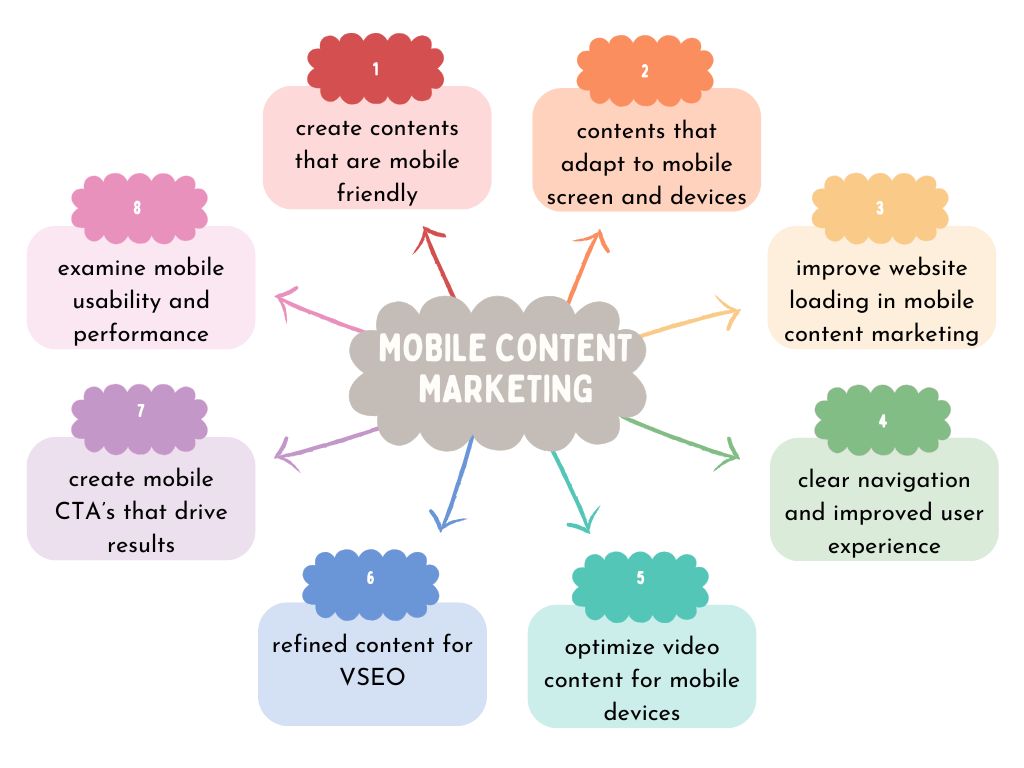Mobile content marketing is rapidly becoming the dominant means of engaging with audiences, as the digital world continues to evolve and mobile devices emerge as the primary entry point to the online world. Your mobile content marketing strategies should focus on creating mobile-friendly content that loads quickly and is easy to navigate on small screens. Prioritize clear, concise messaging and use visually engaging elements like images and videos. Ensure responsive design for seamless viewing across devices, leverage push notifications, and location-based targeting to deliver personalized, timely content, and Regularly analyze user behavior to refine your strategy and boost engagement.
WHAT IS MOBILE CONTENT MARKETING?
Mobile content marketing is the strategic approach of creating and delivering content specifically designed for mobile devices. It is creating content tailored for mobile devices like smartphones and tablets which involves delivering optimized, easy-to-consume content such as text, images, and videos that fit the needs of mobile users. This can include social media posts, push notifications, SMS messages, and location-based offers.
WHY IS MOBILE CONTENT MARKETING IMPORTANT?
Mobile content marketing’s aim is to engage users on their mobile devices with relevant and accessible content. Its optimization extends beyond mere website responsiveness; it’s about creating content that is engaging and much easier to use while having mobile users in mind. Mobile content marketing is all about customizing your content to align with the distinct needs and preferences of mobile users because 60% of people don’t only use their smartphones for browsing social media but also for reading blogs, engaging with interactive content, and watching content videos. To remain effective, brands must evolve their content marketing strategy in response to the shifting landscape of social media consumption and the evolving expectations of the audience.
FUNDAMENTAL PRINCIPLES OF MOBILE ENGAGEMENT YOU SHOULD HAVE IN MIND:
The mobile user’s experience must prioritize clarity, speed, and ease of use, ensuring the pages load quickly, the text is readable, and simple navigation through the content. You must begin a journey to uncover the secret to fostering more meaningful engagement, increased conversation, and enhanced brand loyalty. The stakes are high in mobile content marketing, one misstep, the users will bounce taking their business and their loyalty with them. Will your content help them achieve their goals or hinder their progress?? Well this will help provide you with the tools, inspiration, and motivation needed to succeed in mobile content marketing
There are some fundamental principles of mobile engagement you should have in mind as a mobile content marketer;
#1. Promptness:
Mobile users expect instant access to information and instant gratification.
#2. Simple navigation:
Seamless navigation is essential for mobile users who demand straightforward and uncomplicated access to desired information.
#3. Rapid page loading:
Mobile users expect fast loading times because slow-loading pages lead to an elevated abandonment rate.
#4. Mobile users on the move:
Mobile users are masters of multitasking, so your content needs to be catchy, quick, and valuable.
#5. Limited screen size:
Due to the size of our mobile screens, mobile users need content that’s quick to scan, easy to understand, and nice to look at.
Ultimate Guide to Mobile Content Marketing:
Now that you know some principles governing mobile engagement, Mobile content marketing success relies on strategies prioritizing mobile user experience. Here is the ultimate guide to mobile content marketing:

#1. Create content that is mobile-friendly:
Mobile attention span is short therefore you need to make your content shorter. mobile users typically don’t read content from start to finish, instead, they scan for key points. Use headings, bullet points, and short paragraphs to make your content easy to scan.
#2. Contents that adapt to mobile screens and devices:
The foundation for mobile content marketing is a mobile-compatible website. With responsive design, your website’s content and layout naturally adjust to fit different screen sizes, ensuring that text size and image fit smaller screens without sacrificing features, ensuring a seamless and engaging user experience.
#3. Improve website loading in mobile content marketing:
Mobile devices are often used where internet speed may be slower, so you may lose your audience if your site doesn’t load quickly.
Here are some tips to improve website loading speed for mobile content marketing:
- i.Minify HTML, CSS, and JavaScript: Remove unnecessary characters and whitespace from your code.
- ii. Use a code optimizer: Tools like Google’s Insights can help optimize your code.
- iii. Avoid too many plugins: Limit the number of plugins and extensions to reduce overhead.
- iv. Use the right image format: Choose the most suitable format for your images (e.g., JPEG for photos, PNG for graphics).
- v.Resize images: Scale down large images to reduce file sizes.
- vi. Minify and combine files: Merge multiple CSS and JavaScript files into single, compressed files.
- vii. Use a content delivery network (CDN): Distribute your content across multiple servers to reduce the distance between users and your website.
- viii. Leverage browser caching: Allow browsers to cache frequently used resources to reduce the number of HTTP requests.
- ix. Use mobile-friendly themes: Ensure your website themes are optimized for mobile devices.
- x.Monitor website performance: Regularly check your website’s loading times and performance.
4. Clear navigation and improved user experience in mobile content marketing:
Mobile users expect simple and logical navigation without feeling frustrated. When screens are small, simplicity is key. Avoid overwhelming users with complicated menus or too much information rather optimize navigation by using a clean and basic navigation
menu that is easy to use and find, avoids clutters and only displays the most important link. Navigation can also be optimized by improving accessibility by ensuring that fonts are visible, that contrasts are high enough to read in different lighting conditions, and buttons are large enough to be tapped easily.
5. Optimize video content for mobile devices:
You should optimize video content for mobile users by keeping videos short and engaging, ensuring they load quickly with minimal buffering. Use vertical or square aspect ratios for better display on smaller screens, and add captions for silent viewing because many viewers watch videos without sound. Ensure content is easily accessible with clear calls to action and consider mobile-friendly file sizes to improve performance.
6. Refine content for voice-based search engine optimization (VSEO):
This involves optimizing content to align with how users speak rather than how they type. Since voice search queries tend to be more conversational and natural, VSEO requires a focus on long-tail keywords, question-based phrases, and natural language.
To enhance VSEO:
- i.Use Conversational Language: Structure content to mirror how people ask questions, like “What is the best way to…?”
- ii. Optimize for Featured Snippets: Aim for content that answers common questions succinctly to increase the chance of being featured in voice search results.
- iii. Focus on Local SEO: Voice searches often have local intent, so including location-based keywords can improve visibility. *Improve Site Speed and Mobile Friendliness: Voice search is frequently used on mobile devices, ensuring fast loading times and mobile optimization.
- iv. Use Structured Data: Implementing schema markup helps search engines understand the context of your content, improving voice search results.
7. Create mobile calls to action (CTAs) that drive results:
To create CTAs that drive results, focus on clarity and urgency while addressing the user’s needs. Rather than using vague prompts like “Learn More,” be specific and offer value, such as “Discover Your Solution Now” or “Get Started Instantly.” Craft CTAs that emphasize the benefits users will gain, and make sure they’re easy to find and understand. Consider the user’s journey and provide a logical next step that feels natural and necessary. You will improve conversations by making your CTAs more personalized and action-oriented.
8. Examine mobile usability and performance:
Examining mobile usability and performance means checking how easy and enjoyable an app or website is. Performance analysis includes checking load times, stability, and resource consumption to ensure a smooth and efficient experience on various devices and networks.”
Here’s a detailed checklist for your review:
Conclusion:
In conclusion, optimizing your mobile content marketing strategy for mobile users is essential for staying competitive in today’s digital landscape. By focusing on mobile-friendly design, fast load times, and clear, engaging content, you can enhance user experience and drive better engagement. Don’t forget to leverage SEO best practices like mobile-responsive pages, keyword optimization, and local search strategies to boost your visibility in search engine results. Mobile content marketing is more than just a trend. It is a necessity for staying competitive in an increasingly mobile-driven world. Adapting to mobile trends improves user satisfaction and strengthens your search rankings, ensuring long-term success in your mobile content marketing efforts.
Related Articles
- How to Implement The 3 E’s of Content Marketing in Your Strategy
- What Does a Content Marketing Specialist Do? A Complete Guide
- How to Integrate Content Marketing Automation into Your Existing Marketing Strategy






